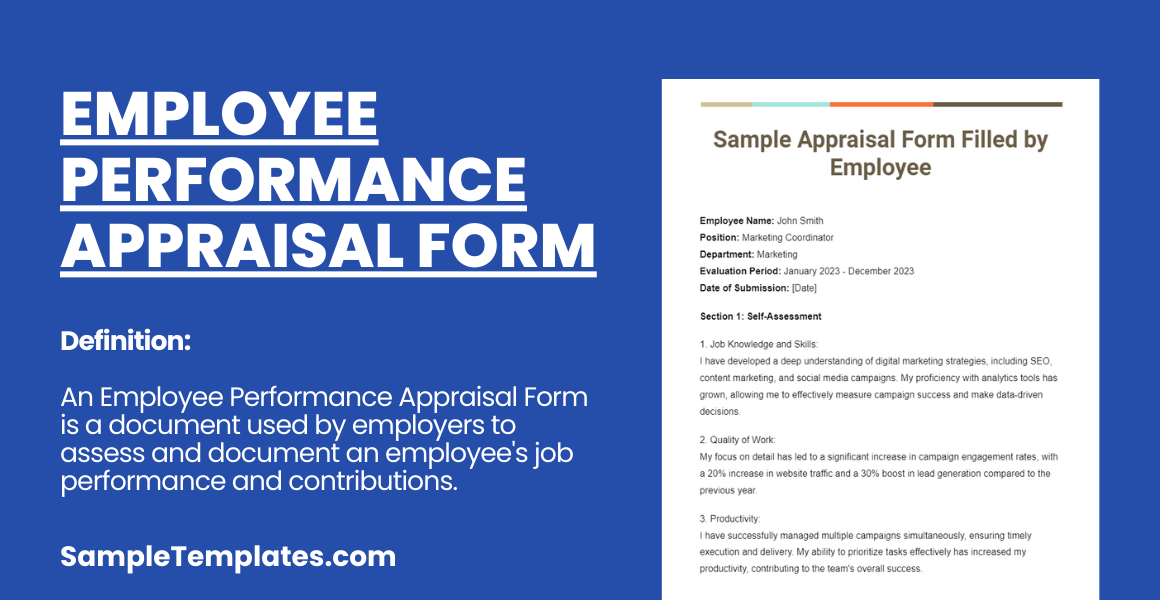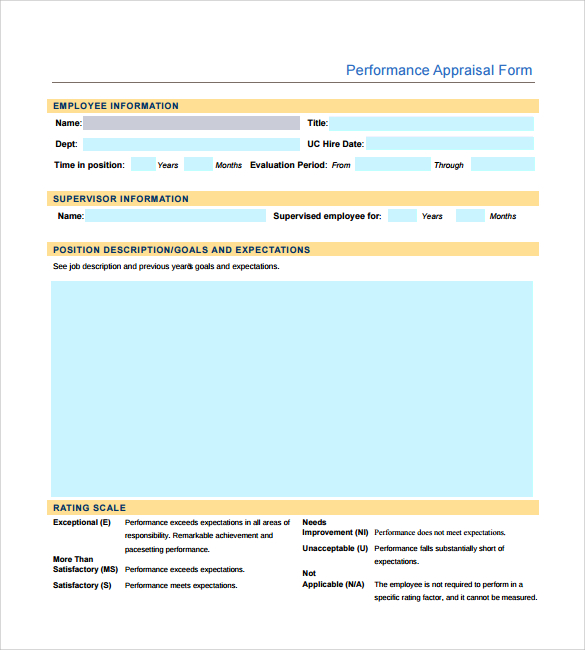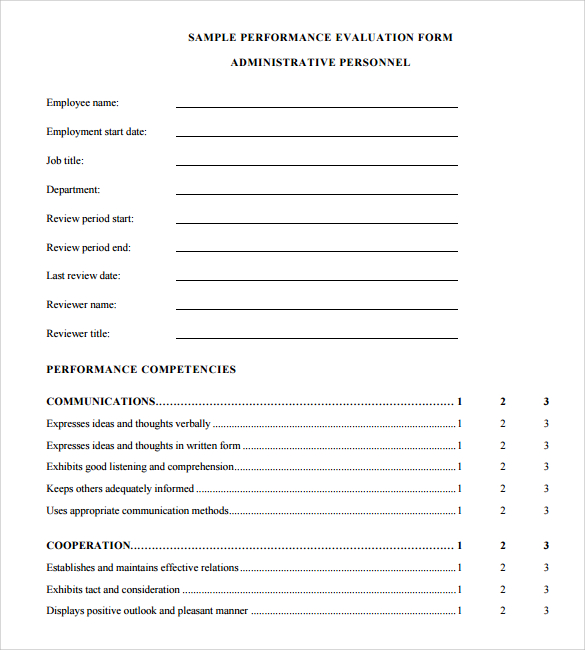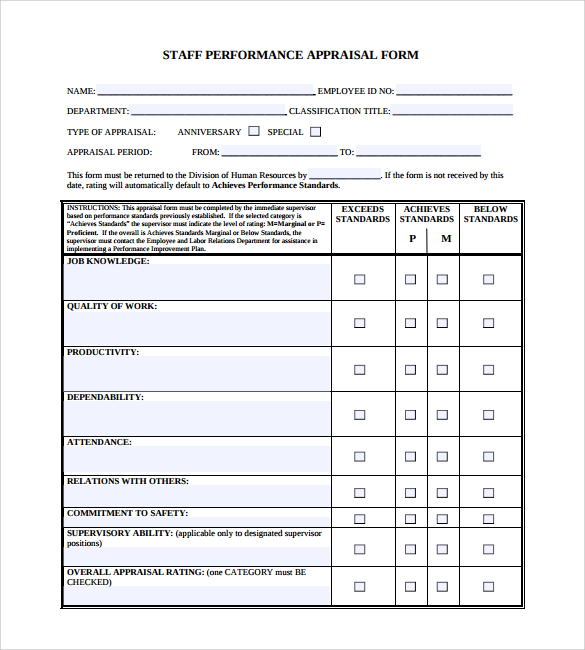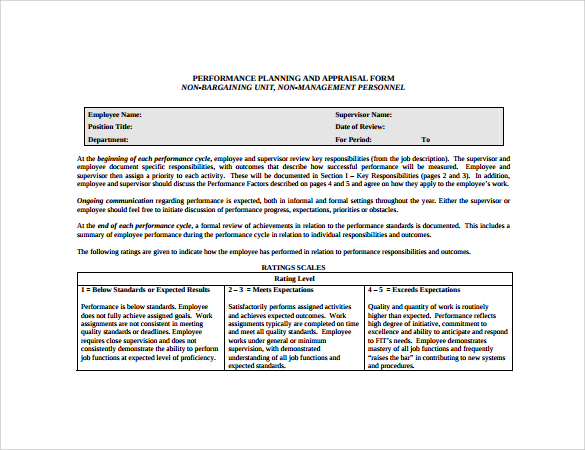An HR will have to pass through different processes in his work period. And the one step that each and every HR person will have to pass is the Employee appraisal process. Without a doubt, it’s the trickiest part. Most of the disputes in an organisation happen in that step and it has to be handled carefully, yet systematically. Each of the appraisal meetings will require an employee appraisal Student Evaluation Form where the basic details of them, the employee will be collected and his performance will be scored. If the document could convey your staff, about his positives and areas to be improved, he will be satisfied with the approval as well. Let’s see some of the one effective employee appraisal form that will make your job easier
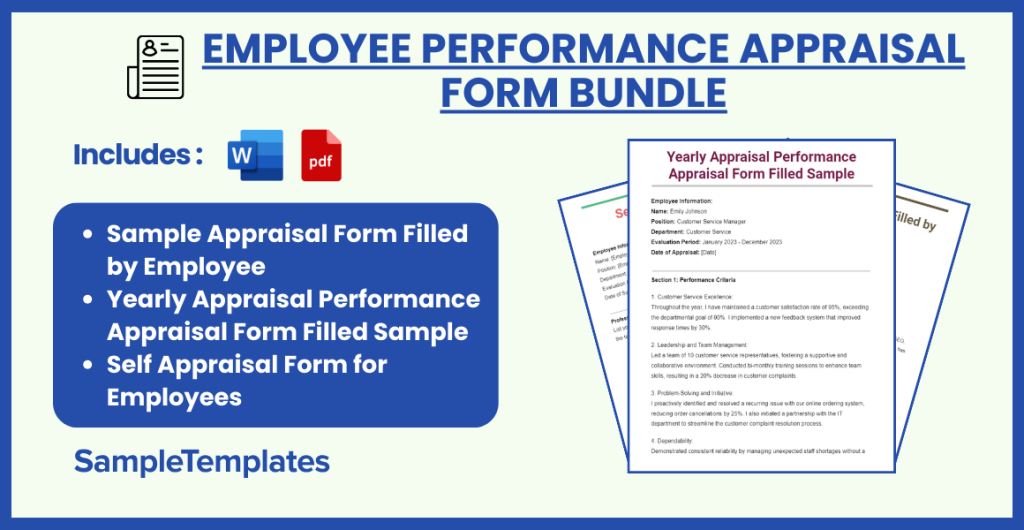
Download Employee Performance Appraisal Form Bundle
Sample Appraisal Form Filled by Employee
Employee Name: John Smith
Position: Marketing Coordinator
Department: Marketing
Evaluation Period: January 2023 – December 2023
Date of Submission: [Date]
Section 1: Self-Assessment
1. Job Knowledge and Skills:
I have developed a deep understanding of digital marketing strategies, including SEO, content marketing, and social media campaigns. My proficiency with analytics tools has grown, allowing me to effectively measure campaign success and make data-driven decisions.
2. Quality of Work:
My focus on detail has led to a significant increase in campaign engagement rates, with a 20% increase in website traffic and a 30% boost in lead generation compared to the previous year.
3. Productivity:
I have successfully managed multiple campaigns simultaneously, ensuring timely execution and delivery. My ability to prioritize tasks effectively has increased my productivity, contributing to the team’s overall success.
4. Initiative:
I introduced a new social media platform strategy that targeted a younger demographic, resulting in a 15% increase in our audience reach among that group. This initiative also opened up new avenues for brand partnerships.
5. Teamwork and Cooperation:
I have actively collaborated with the sales team to align marketing efforts with sales goals, leading to a more cohesive strategy and improved sales leads quality.
6. Dependability:
I have consistently met deadlines and exceeded expectations in campaign delivery. My reliability has been acknowledged by my team and superiors, making me a go-to person for critical projects.
7. Communication Skills:
I have effectively communicated campaign strategies and results to stakeholders at all levels, ensuring transparency and alignment with company goals. My presentations to the management team have been well-received, leading to quicker decision-making processes.
Section 2: Achievements
- Successfully launched 4 major marketing campaigns, exceeding KPIs by an average of 25%.
- Developed a content marketing strategy that increased customer engagement by 40%.
- Led a cross-departmental project to integrate CRM software, enhancing customer data analysis capabilities.
Section 3: Goals for Next Evaluation Period
- Implement an advanced SEO strategy to increase organic search traffic by 30%.
- Develop a training program for new team members on digital marketing best practices.
- Explore emerging markets and platforms to expand our brand presence.
Section 4: Professional Development Needs
I seek to enhance my skills in data science and analytics to leverage big data for more targeted marketing strategies. Attending workshops or courses in this area would be beneficial.
Employee’s Signature: John Smith
Date: [Date]
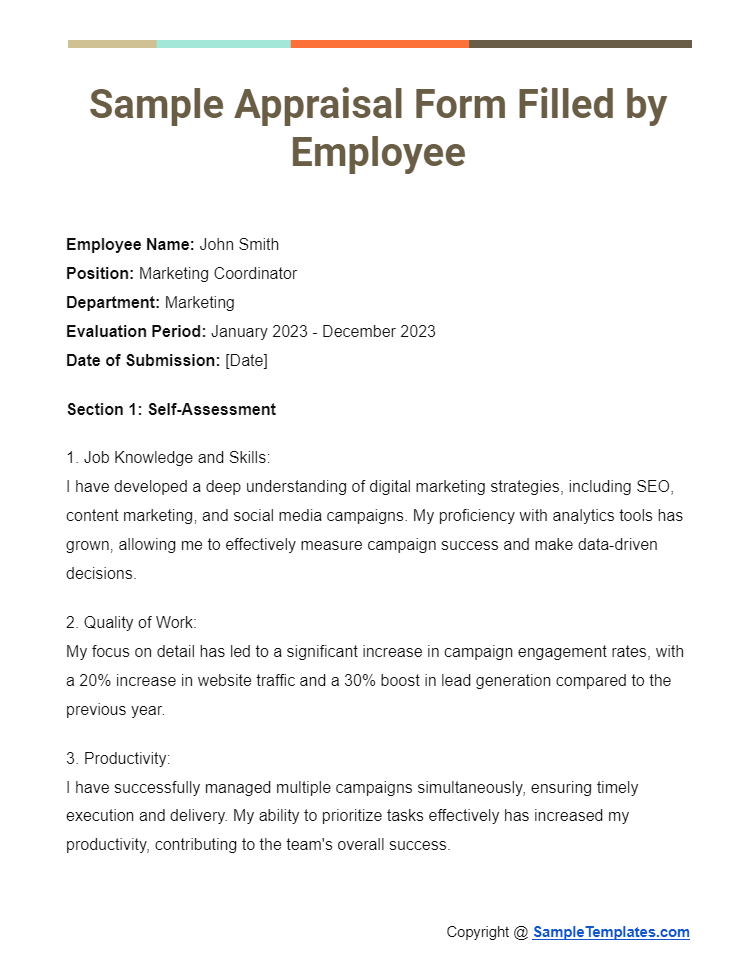
Yearly Appraisal Performance Appraisal Form Filled Sample
Employee Information:
Name: Emily Johnson
Position: Customer Service Manager
Department: Customer Service
Evaluation Period: January 2023 – December 2023
Date of Appraisal: [Date]
Section 1: Performance Criteria
1. Customer Service Excellence:
Throughout the year, I have maintained a customer satisfaction rate of 95%, exceeding the departmental goal of 90%. I implemented a new feedback system that improved response times by 30%.
2. Leadership and Team Management:
Led a team of 10 customer service representatives, fostering a supportive and collaborative environment. Conducted bi-monthly training sessions to enhance team skills, resulting in a 20% decrease in customer complaints.
3. Problem-Solving and Initiative:
I proactively identified and resolved a recurring issue with our online ordering system, reducing order cancellations by 25%. I also initiated a partnership with the IT department to streamline the customer complaint resolution process.
4. Dependability:
Demonstrated consistent reliability by managing unexpected staff shortages without a drop in service quality. I ensured all customer inquiries were addressed timely, maintaining our department’s reputation for dependability.
5. Communication:
Effectively communicated across departments to ensure customer needs were met and maintained clear, open communication with my team. I developed a monthly newsletter to keep staff updated on new policies and customer service best practices.
Section 2: Key Achievements
- Introduced a mentorship program for new hires, reducing training time by 40% and improving new employee satisfaction.
- Negotiated with software vendors to upgrade our customer relationship management (CRM) system, enhancing data analysis capabilities and personalizing customer interactions.
- Organized a successful customer service week, boosting team morale and highlighting our commitment to customer satisfaction.
Section 3: Goals for Next Year
- Develop and implement an advanced training program focusing on emotional intelligence and conflict resolution.
- Launch a customer loyalty program aimed at increasing repeat business by 15%.
- Increase team efficiency through the integration of AI chatbots for basic inquiries, freeing up representatives for complex issues.
Section 4: Professional Development Needs
To better support my goals and the department, I would benefit from leadership training, specifically in strategic planning and change management. Additionally, attending a conference on customer experience innovations could provide valuable insights into industry trends.
Employee Comments:
This year has been challenging yet rewarding, and I am proud of the strides we’ve made in enhancing customer satisfaction and team performance. I am committed to continuing this positive trajectory and look forward to contributing to our success in the coming year.
Employee’s Signature: Emily Johnson
Date: [Date]
Supervisor’s Comments:
Emily has shown exemplary performance and leadership throughout the year. Her initiatives have directly contributed to the department’s success, making her an invaluable asset to the team. We support her proposed goals and professional development plans.
Supervisor’s Signature: [Supervisor’s Name]
Date: [Date]
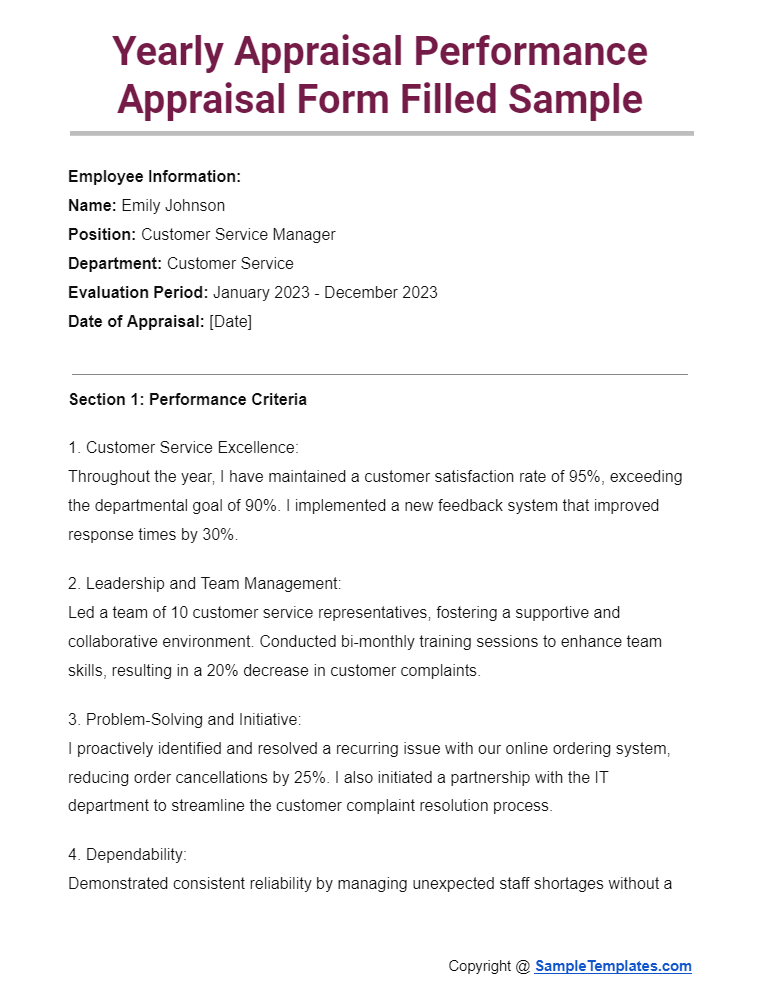
Self Appraisal Form for Employees
Employee Information
Name: [Employee Name]
Position: [Employee Position]
Department: [Department Name]
Evaluation Period: [Start Date] to [End Date]
Date of Submission: [Date]
Professional Achievements
List your key accomplishments during the evaluation period that you feel contribute to the team and organization’s success.
- Achievement 1: [Description]
- Achievement 2: [Description]
- Achievement 3: [Description]
Strengths and Skills
Identify your core strengths and skills that have been beneficial in your role and to the organization.
- Strength/Skill 1: [Description]
- Strength/Skill 2: [Description]
- Strength/Skill 3: [Description]
Areas for Improvement
Discuss any areas you feel you could improve on or wish to develop further.
- Area for Improvement 1: [Description]
- Area for Improvement 2: [Description]
- Area for Improvement 3: [Description]
Professional Development Activities
Outline any professional development activities or training you have undertaken or wish to undertake to improve your skills and job performance.
- Activity/Training 1: [Description]
- Activity/Training 2: [Description]
- Activity/Training 3: [Description]
Goals for Next Evaluation Period
Set specific, measurable goals you aim to achieve by the next evaluation period.
- Goal 1: [Description]
- Goal 2: [Description]
- Goal 3: [Description]
Feedback for Management
Provide any feedback or suggestions you have for management that could help improve your work environment, processes, or professional growth.
- Feedback/Suggestion 1: [Description]
- Feedback/Suggestion 2: [Description]
- Feedback/Suggestion 3: [Description]
Additional Comments
Include any other comments or information you believe is relevant to your self-appraisal.
[Your Additional Comments]
Employee’s Signature: _______________________ Date: _________
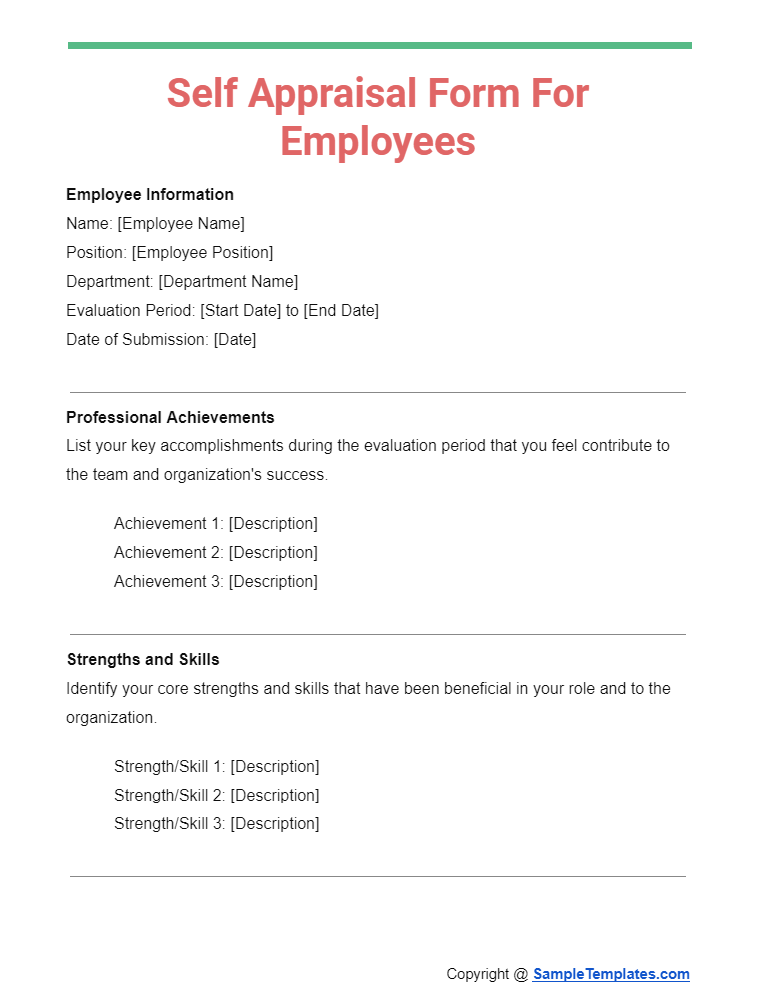
Browse More Templates On Employee Performance Appraisal Form
Appraisal Form
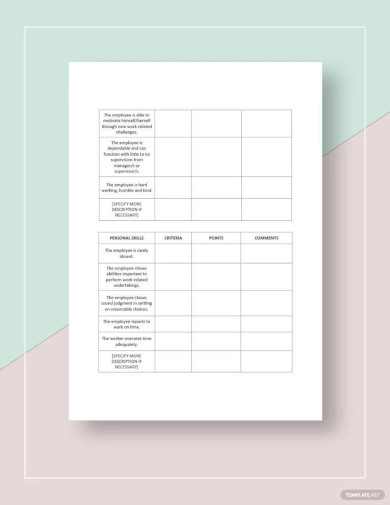
Appraisal Form Format
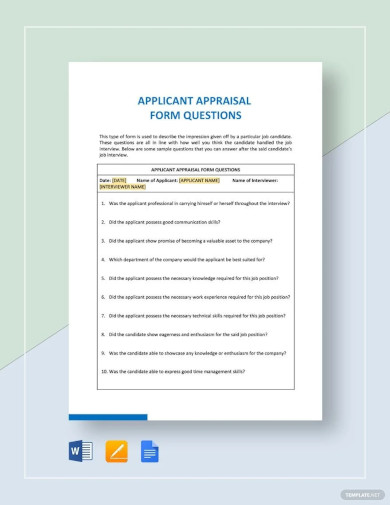
Employee Appraisal Form
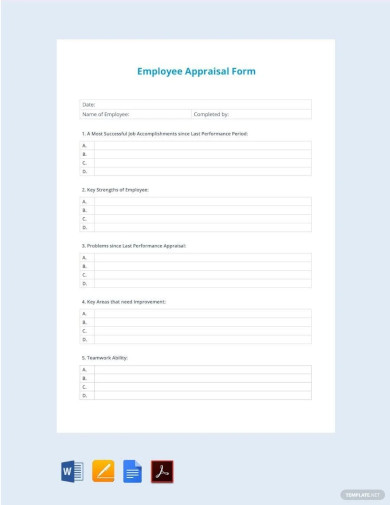
Appraisal Form Sample
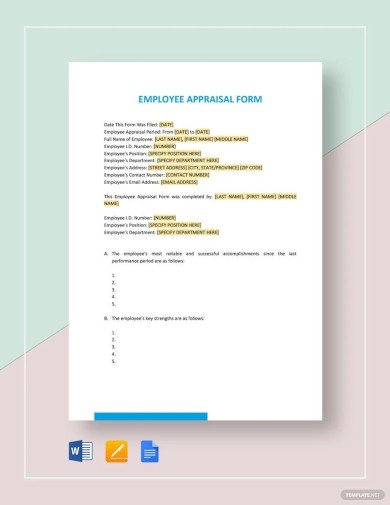
Performance Appraisal Form

Sample Appraisal Form for Employees
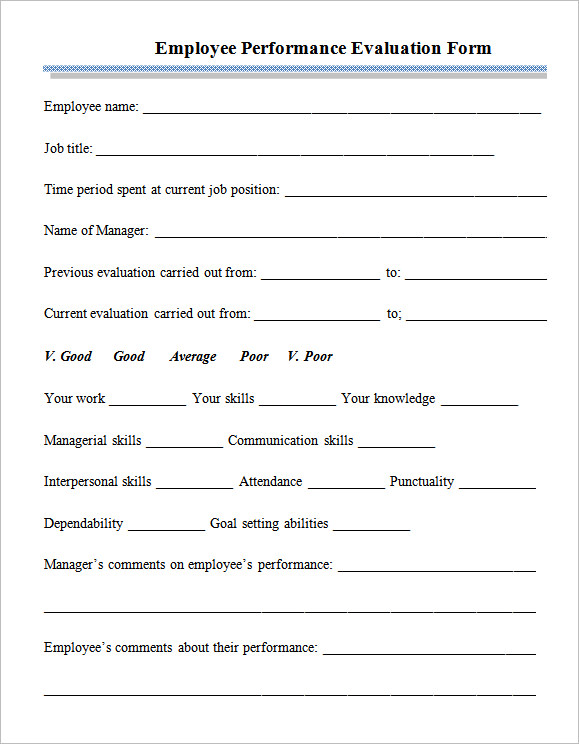
This form consists of the fields to fill out the basic employee details. The details are very relevant and is being organised in a nice way. This form can save the time being spent to fill unwanted fields. The performance parameters asked are also in a very crisp and short way. This will help save the time of the HR person too.
Tips for Completing Employee Performance Appraisal Forms
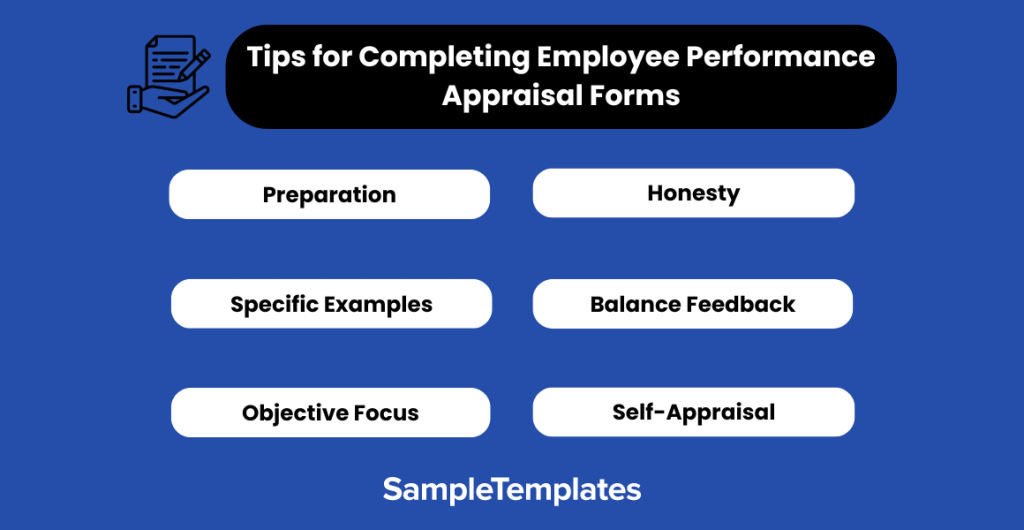
- Be Prepared: Gather all relevant documentation, including previous appraisals, project reports, and feedback from colleagues, to ensure a comprehensive review.
- Use Specific Examples: Support your evaluations with concrete examples. Describe instances where the employee excelled or areas where improvement is needed, providing context and detail.
- Focus on Objectives: Align the appraisal with the employee’s job objectives and the organization’s goals. Assess how well the employee has met these objectives during the evaluation period.
- Be Honest and Objective: Provide an honest assessment of the employee’s performance. Objectivity is crucial; base your evaluation on observed behaviors and outcomes, not personal biases.
- Balance Positives and Negatives: Ensure that your appraisal acknowledges the employee’s strengths and achievements while also addressing areas for improvement. A balanced approach fosters motivation and growth.
- Encourage Self-Appraisal: Before completing the form, ask the employee to conduct a self-appraisal. This encourages self-reflection and can provide valuable insights into the employee’s perspective on their performance and goals.
- Set SMART Goals: Use the appraisal process to set Specific, Measurable, Achievable, Relevant, and Time-bound (SMART) goals for the next evaluation period. This gives the employee clear direction and something concrete to work towards.
- Offer Support: End the appraisal with a commitment to support the employee’s development. Discuss training opportunities, resources, and any other support the employee might need to achieve their goals and improve performance.
Performance Appraisal Form Download Free
Uses of a Sample-Worth the Effort if Download
The working procedures and the key performance indicators of each company vary with its area of expertise, domain and the type of management. Appraisal methods and forms are also not an exception. So in short, each company will have its own ways of appraising Employees Evaluation Form and each of the modes will have different forms also. Bringing these indicators altogether in a form is not s simple task. If we have a sample with us, the process will be somewhat easier. For these, there are a lot of downloadable forms available on the internet. These can be used as a good reference and sometimes a good base copy as well.
Who can use this?
Free downloadable forms are indeed helpful for those who work in human resource department. Even though it’s completely depending on HR, These referral forms can be downloaded and saved by those who are on the management level too. The ultimate hike will be decided by the management and HR Altogether. So a referral form with the manager will be helpful while doing the process An employee Course Evaluation Form can have an idea about appraisals and methods if he refers some sample forms before his review process. So that he can fill the form without errors and can update his form with perfection. Impression matters, even at the filling of forms!
Save Time and Effort, with Some Money!
The benefit of a sample is not limited to one or two. Getting a basic idea about an appraisal form doesn’t come handy without an example. When you use a sample form, you are on 2 things together. One; is getting basic details about what and how the form is. Another understands the dos and don’ts in the form. Also, some forms available in word format are easily editable and could be re-used by you. This will save a lot of your productive time and will help you to go through an error free process. This will overall give a positive impact to you and the firm.
A sample employee appraisal form might help you to save a lot of time and some extra bugs. These free downloadable forms will help to get you through a bug-free process and will finally make your performance a step ahead of what you are expected to deliver!
Performance Appraisal Format
How do you write a Good Performance Appraisal Form?
- Clear Objectives: Clearly state the objectives and purpose of the appraisal.
- Specific Metrics: Define specific performance metrics and key indicators relevant to the role.
- Employee Self-Evaluation: Include a section for employees to self-evaluate, fostering self-awareness.
- Constructive Feedback: Provide constructive and specific feedback on strengths and areas for improvement.
- Goal Alignment: Align performance assessment with both individual and company goals.
- Continuous Improvement: Encourage suggestions for ongoing improvement and professional development.
- Training Needs: Identify training needs and opportunities for skill enhancement.
- Fair Rating System: Use a fair and transparent rating system that reflects actual performance.
- Open Communication: Promote open communication, allowing for employee input and questions.
- Future Goals: Include a section for setting and discussing future goals and objectives.
By incorporating these elements, you can create a comprehensive and constructive performance appraisal form that facilitates meaningful discussions and contributes to employee growth and development.
Staff Performance Appraisal Form
Why use the Employee Performance Appraisal Form?
The employee performance appraisal form serves as a structured tool to systematically assess and document an individual’s job performance. Its primary purpose is to provide a comprehensive overview of achievements, areas for improvement, and alignment with organizational goals. This process fosters transparent communication between employees and supervisors, identifies development opportunities, and supports informed decision-making on promotions, salary adjustments, and training initiatives. By facilitating a constructive dialogue, the appraisal form contributes to professional growth, job satisfaction, and organizational success by ensuring that individual efforts align with the broader objectives and expectations of the company.
Appraisal Form Examples
What is employee appraisal form?
An employee appraisal form is a structured document used to assess and evaluate an employee’s performance, aligning with key performance indicators, providing feedback, and identifying areas for improvement or recognition.
What is the role of HR in performance appraisal?
HR plays a pivotal role in performance appraisal by designing appraisal systems, ensuring fairness, providing training, facilitating communication, and using appraisals for talent management and organizational development.
What is a good performance appraisal?
A good performance appraisal is comprehensive, fair, and constructive. It provides a balanced assessment of an employee’s achievements, areas for improvement, and aligns with organizational goals, fostering professional growth.
How do I write my own appraisal?
To write your own appraisal, reflect on achievements and challenges, align with job objectives, provide specific examples, and set SMART goals for improvement based on honest self-assessment.
What are staff appraisal forms?
Staff appraisal forms are documents used by employers to assess employees’ performance, skills, and development goals. They facilitate discussions about job performance, strengths, weaknesses, and areas for improvement.
How to fill HR appraisal form?
To fill an HR appraisal form, provide honest, specific details about your accomplishments, challenges, and goals. Reflect on your performance, showcase achievements, and discuss areas for improvement.
How often should performance appraisals be conducted?
Performance appraisals should be conducted annually to provide employees with feedback, set goals, and assess their achievements. Regular communication and feedback throughout the year can enhance the process.
The Employee Performance Appraisal Form is a critical tool in evaluating and enhancing an individual’s contributions to an organization. It provides a structured approach to assessing performance, identifying areas for improvement, and setting goals for future growth. Properly utilized, it fosters open communication between employees and managers, aligns individual objectives with organizational goals, and ultimately drives professional development and organizational success.
Related Posts
Agreement Form Samples & Templates
Vehicle Inspection Forms Samples & Templates
Sample Employee Advance Forms
Sample Child Travel Consent Forms
Sample Testimonial Request Forms
Sample Employee Details Forms
Sample Divorce Forms
Sample Attestation Forms
FREE 9+ Sample Presentation Evaluation Forms in MS Word
FREE 10+ School Admission Form Samples & Templates in MS Word | PDF
FREE 30+ Patient Consent Form Samples in PDF | MS Word
FREE 10+ Sample Sign Off Form Templates in PDF | MS Word
FREE 11+ Sample Medical Consultation Forms in PDF | MS Word
FREE 8+ Sample Donation Forms in PDF | MS Word
FREE 20+ Peer Review Form Samples in PDF
